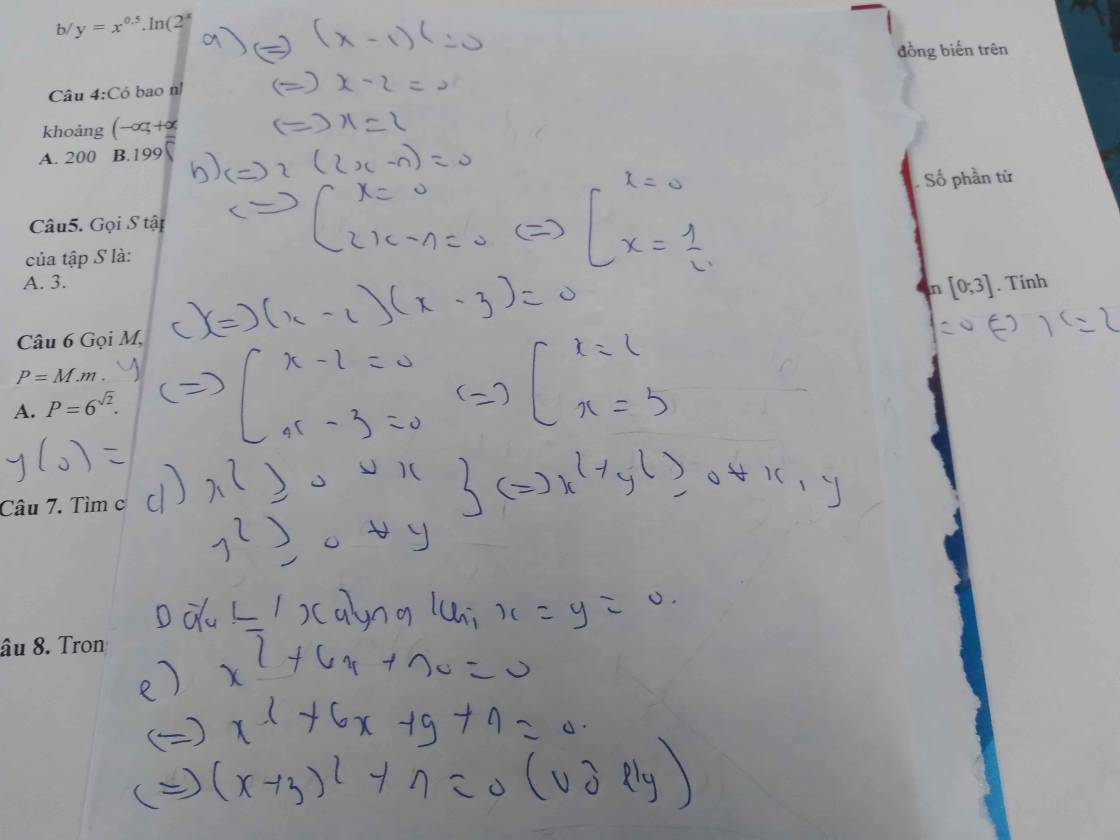x2+6x+6=0

Những câu hỏi liên quan
Bài 6: a)Tìm GTLN, GTNN của biểu thức sau:a. x2 – 6x +11 b. –x2 + 6x – 11 c) Chứng minh rằng: x2 + 2x + 2 0 với x Z
Đọc tiếp
Bài 6: a)Tìm GTLN, GTNN của biểu thức sau:
a. x2 – 6x +11 b. –x2 + 6x – 11
c) Chứng minh rằng: x2 + 2x + 2 > 0 với x Z
c: \(=\left(x+1\right)^2+1>0\forall x\)
Đúng 0
Bình luận (0)
Trả lời:
a, \(x^2-6x+11=x^2-6x+9+2=\left(x-3\right)^2+2\ge2\forall x\)
Dấu "=" xảy ra khi x - 3 = 0 <=> x = 3
Vậy GTNN của biểu thức bằng 2 khi x = 3
b, \(-x^2+6x-11=-\left(x^2-6x+11\right)=-\left(x^2-6x+9+2\right)=-\left[\left(x-3\right)^2+2\right]\)
\(=-\left(x-3\right)^2-2\le-2\forall x\)
Dấu "=" xảy ra khi x - 3 = 0 <=> x = 3
Vậy GTLN của biểu thức bằng - 2 khi x = 3
c, \(x^2+2x+2=x^2+2x+1+1=\left(x+1\right)^2+1\ge1>0\forall x\inℤ\) (đpcm)
Dấu "=" xảy ra khi x + 1 = 0 <=> x = - 1
X2- 6x +6=0
2x-6x+6=0
<=> -4x=-6
<=> x= 6/4 = 3/2 ( Cách giải này chuyển vế đối dấu hạng tử nha chị, nếu vế 1 hạ xuống ở vế 1 thì ta ko đổi, mà đổi xuống vế 2 chúng ta mới đổi. Ngược lại vế 2 cũng vậy ! )
Đúng 0
Bình luận (0)
nếu như tui nghĩ
pt \(x^2-6x+6=0\)
(a=1 , b' =-3 , c=6)
ta có công thức của (đen ta)'\(b^2-ac\)=9-6=3> 0
=> \(\sqrt{đenta}\)=\(\sqrt{3}\)
vậy hệ phương trình có 2 ngiệm phân biệt
=>\(x_1=\frac{-b'+\sqrt{đenta}'}{a}=\frac{3+\sqrt{3}}{1}\)
\(x_2=\frac{-b'-\sqrt{đenta}'}{a}=\frac{3-\sqrt{3}}{1}\)
Đúng 0
Bình luận (0)
Giải phương trình:
a)x2-4x+4=0
b)2x2-x=0
c)x2-5x+6=0
d)x2+y2=0
e)x2+6x+10=0
\(a.x^2-4x+4=0\)
\(\left(x-2\right)^2=0\)
=>x=2
b) \(2x^2-x=0\)
\(x\left(2x-1\right)=0\)
=> \(\left[{}\begin{matrix}x=0\\x=\dfrac{1}{2}\end{matrix}\right.\)
c) \(x^2-5x+6=0\)
\(x^2-2x-3x+6=0\)
\(\left(x-2\right)\left(x-3\right)=0\)
=> \(\left[{}\begin{matrix}x=2\\x=3\end{matrix}\right.\)
d) \(x^2+y^2=0\)
Vì \(x^2,y^2\ge0\forall x,y\)
=>x=y=0
e) \(x^2+6x+10=0\)
\(\left(x+3\right)^2+1=0\)
Vì \(\left(x+3\right)^2\ge0\forall x\)
=> VT>0 \(\forall x\)
=> phương trình vô nghiệm
Đúng 3
Bình luận (0)
a) \(x^2-4x+4=0\)
\(\Leftrightarrow\left(x-2\right)^2=0\)
\(\Leftrightarrow x-2=0\)
\(\Leftrightarrow x=2\)
b) \(2x^2-x=0\)
\(\Leftrightarrow x\left(2x-1\right)=0\)
\(\Leftrightarrow\left[{}\begin{matrix}x=0\\2x-1=0\end{matrix}\right.\) \(\Leftrightarrow\left[{}\begin{matrix}x=0\\x=\dfrac{1}{2}\end{matrix}\right.\)
c) \(x^2-5x+6=0\)
\(\Leftrightarrow\left[{}\begin{matrix}x=2\\x=3\end{matrix}\right.\) \(\left(a+b+c=0\right)\)
d) \(x^2+y^2=0\)
\(\Leftrightarrow\left\{{}\begin{matrix}x^2=0\\y^2=0\end{matrix}\right.\) \(\Leftrightarrow\left\{{}\begin{matrix}x=0\\y=0\end{matrix}\right.\)
e) \(x^2+6x+10=0\)
\(\Leftrightarrow x^2+6x+9+1=0\)
\(\Leftrightarrow\left(x+3\right)^2+1=0\left(1\right)\)
mà \(\left(x+3\right)^2+1\ge1>0,\forall x\in R\)
Nên phương trình (1) vô nghiệm
Đúng 0
Bình luận (0)
Các cặp phương trình sau đây có tương đương không? Vì sao?a)
x
2
−
6
x
+
9
0
và
x
2
+
1
2
x
−
6
0
b)
x
2...
Đọc tiếp
Các cặp phương trình sau đây có tương đương không? Vì sao?
a) x 2 − 6 x + 9 = 0 và x 2 + 1 2 x − 6 = 0
b) x 2 + 1 2 x − 1 = 0 và 2 x 4 + 1 = 0
GIẢI CÁC PT SAU:
x2 - 6x + 9=\(4\sqrt{x^2-6x+6}\)
x2 - x + 8 - \(4\sqrt{x^2-x+4}=0\)
x2 + \(\sqrt{4x^2-12x+44}=3x+4\)
a) x2 + 4x = -3 b)3x2 + 4x – 4 = 0 c)x2 +5x - 6 = 0 d)x2 – 6x = -9
mọi người giải giúp em ạ
\(a,x^2+4x=-3\Leftrightarrow x^2+4x+3=0\Leftrightarrow\left(x+1\right)\left(x+3\right)=0\)
\(\left[{}\begin{matrix}x=-1\\x=-3\end{matrix}\right.\)
\(b,3x^2+4x-4=0\Leftrightarrow3x^2+6x-2x-4=0\Leftrightarrow3x\left(x+2\right)-2\left(x+2\right)=0\Leftrightarrow\left(3x-2\right)\left(x+2\right)=0\)
\(\left[{}\begin{matrix}x=-2\\3x=2\end{matrix}\right.\)
\(\left[{}\begin{matrix}x=-2\\x=\frac{2}{3}\end{matrix}\right.\)
\(c,x^2+5x-6=0\Leftrightarrow\left(x-1\right)\left(x+6\right)=0\)
\(\left[{}\begin{matrix}x=1\\x=-6\end{matrix}\right.\)
\(d,x^2-6x=-9\Leftrightarrow x^2+6x+9=0\Leftrightarrow\left(x-3\right)^2=0\Leftrightarrow x-3=0\Leftrightarrow x=3\)
Bài 2: Tìm x, biết:
a) 4x(x + 1) = 8( x + 1) c) x2 – 6x + 8 = 0
b) x3 + x2 + x + 1 = 0 d) x3 – 7x – 6 = 0
\(a,\Leftrightarrow\left(4x-8\right)\left(x+1\right)=0\\ \Leftrightarrow4\left(x-2\right)\left(x+1\right)=0\Leftrightarrow\left[{}\begin{matrix}x=2\\x=-1\end{matrix}\right.\\ b,\Leftrightarrow\left(x+1\right)\left(x^2+1\right)=0\\ \Leftrightarrow\left[{}\begin{matrix}x=-1\\x^2=-1\left(vô.lí\right)\end{matrix}\right.\Leftrightarrow x=-1\\ c,\Leftrightarrow x^2-2x-4x+8=0\\ \Leftrightarrow\left(x-2\right)\left(x-4\right)=0\Leftrightarrow\left[{}\begin{matrix}x=2\\x=4\end{matrix}\right.\\ d,\Leftrightarrow x^3-3x^2+3x-9x+2x-6=0\\ \Leftrightarrow\left(x-3\right)\left(x^2+3x+2\right)=0\\ \Leftrightarrow\left(x-3\right)\left(x^2+x+2x+2\right)=0\\ \Leftrightarrow\left(x-3\right)\left(x+1\right)\left(x+2\right)=0\\ \Leftrightarrow\left[{}\begin{matrix}x=3\\x=-1\\x=-2\end{matrix}\right.\)
Đúng 1
Bình luận (0)
a) \(\Rightarrow4\left(x+1\right)\left(x-2\right)=0\)
\(\Rightarrow\left[{}\begin{matrix}x=-1\\x=2\end{matrix}\right.\)
b) \(\Rightarrow x^2\left(x+1\right)+\left(x+1\right)=0\)
\(\Rightarrow\left(x+1\right)\left(x^2+1\right)=0\)
\(\Rightarrow x=-1\left(do.x^2+1\ge1>0\right)\)
c) \(\Rightarrow x\left(x-4\right)-2\left(x-4\right)=0\)
\(\Rightarrow\left(x-4\right)\left(x-2\right)=0\)
\(\Rightarrow\left[{}\begin{matrix}x=4\\x=2\end{matrix}\right.\)
d) \(\Rightarrow x^2\left(x-3\right)+3x\left(x-3\right)+2\left(x-3\right)\)
\(\Rightarrow\left(x-3\right)\left(x^2+3x+2\right)=0\)
\(\Rightarrow\left(x-3\right)\left(x+1\right)\left(x+2\right)=0\)
\(\Rightarrow\left[{}\begin{matrix}x=3\\x=-2\\x=-1\end{matrix}\right.\)
Đúng 1
Bình luận (0)
a) (2x +1)(3 – x)(4 - 2x) = 0 b)2x(x – 3) + 5(x – 3) = 0
c) (x2 – 4) – (x – 2)(3 – 2x) = 0 d) x2 – 5x + 6 = 0
e) (2x + 5)2 = (x + 2)2 f) 2x3 + 6x2 = x2 + 3x
a: (2x+1)(3-x)(4-2x)=0
=>(2x+1)(x-3)(x-2)=0
hay \(x\in\left\{-\dfrac{1}{2};3;2\right\}\)
b: 2x(x-3)+5(x-3)=0
=>(x-3)(2x+5)=0
=>x=3 hoặc x=-5/2
c: =>(x-2)(x+2)+(x-2)(2x-3)=0
=>(x-2)(x+2+2x-3)=0
=>(x-2)(3x-1)=0
=>x=2 hoặc x=1/3
d: =>(x-2)(x-3)=0
=>x=2 hoặc x=3
e: =>(2x+5+x+2)(2x+5-x-2)=0
=>(3x+7)(x+3)=0
=>x=-7/3 hoặc x=-3
f: \(\Leftrightarrow2x^3+5x^2-3x=0\)
\(\Leftrightarrow x\left(2x^2+5x-3\right)=0\)
\(\Leftrightarrow x\left(x+3\right)\left(2x-1\right)=0\)
hay \(x\in\left\{0;-3;\dfrac{1}{2}\right\}\)
Đúng 2
Bình luận (0)
Trong mặt phẳng tọa độ Oxy, cho đường tròn (C): x2 + y2 - 2x + 6x - 6 =0.Tiếp tuyến của (C) vuông góc với đường thẳng: 6x+8y-3=0 , có phương trình là ax+by+c=0 (a<5, c<0). Tính 2a+5b-c=?
Đường tròn (C) tâm I(1;-3) bán kính \(R=4\)
Tiếp tuyến d vuông góc với 6x+8y-3=0 nên nhận \(\left(4;-3\right)\) là 1 vtpt
Tiếp tuyến d có dạng: \(4x-3y+c=0\)
\(d\left(I;d\right)=R\Leftrightarrow\dfrac{\left|4.1-3.\left(-3\right)+c\right|}{\sqrt{4^2+\left(-3\right)^2}}=4\)
\(\Leftrightarrow\left|c+13\right|=20\Rightarrow\left[{}\begin{matrix}c=7\left(loại\right)\\c=-33\end{matrix}\right.\)
\(\Rightarrow\left\{{}\begin{matrix}a=4\\b=-3\\c=-33\end{matrix}\right.\)
Đúng 0
Bình luận (0)


























